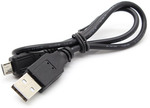Details:
All four pins inside are used to deliver power
Works with most Android devices supporting the 4-pin high speed charging protocol
Charges twice as fast as regular micro-USB cables
Compatible with most Android based devices featuring fast charge / quick charge capabilities
Cannot be used to sync or transfer data
Supports the following devices (excluding custom kernel/hardware variations):
HTC 8X, Droid DNA, Evo 4G LTE, One S, One VX, One SV
LG Escape, Mach, Motion 4G, Nexus 4, Optimus G, Spectrum 2, Optimus Regard
Motorola Atrix HD LTE, Droid RAZR HD, Droid RAZR M, Electrify M, Photon Q 4G LTE, Droid RAZR Maxx HD
Pantech Flex
Nokia Lumia 820, 822, 920, 1020
ZTE/Sprint Flash
Samsung Galaxy Express, Rugby Pro, Galaxy S Relay 4G, Galaxy S III, Galaxy Victory 4G, Galaxy Tab 2 10.1 LTE, Galaxy Tab 2 7.0 LTE,
Galaxy Tab 7.7 Plus
Sony Xperia TL
Blackberry Q5, Q10, Z10, Z30, Bold.
and more..


anyone knows if the kogan cable is better than the one posted here. needing one to charge the Samsung phones.
http://www.kogan.com/au/buy/micro-usb-to-usb-cable-1m/